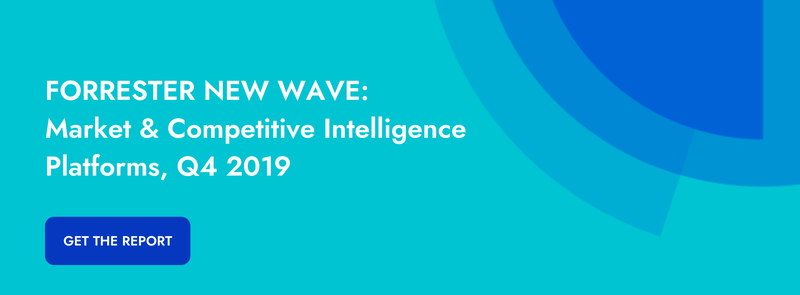Choosing the best competitive intelligence (CI) solution for your business isn’t always a quick and easy process. To ensure that the solution you choose meets all of your needs and delivers results, you should identify the relevant criteria for solution that will support your goals and evaluate each potential solution against those criteria.
Recently, Crayon was named a Leader in The Forrester New Wave™ on Market and Competitive Intelligence (CI) Platforms. Here are the 10 criteria they used to evaluate the top market and competitive intelligence platforms and why we believe they’re important to consider in your evaluation.
User Experience
User Experience (UX) is a good starting point when evaluating your potential solutions. In an ideal world, all of the programs we use would have an easy UX and be designed exactly as we want them to be. However, the truth is that sometimes, programs aren’t easy to use or navigate around, which makes for a terrible user experience and inhibit our usage.
When it comes to consuming your competitive intelligence data, you want to be able to see everything in one place. You also want it to be organized in the best way for you and your team, so that you're able to create deliverables that can be used by everyone. The harder a platform is to navigate, the less likely you are to successfully consume the data and create those powerful enablement materials. When viewing a demo of the product, make sure that the platform is easy to use, and creates a seamless user experience.
DOWNLOAD OUR AMAZING REPORT YAYAYAY ↓
Download The Forrester New Wave: Market and Competitive Intelligence Platforms, Q4 2019
Data Collection / Taxonomy
To get a complete picture of your competitive landscape, you need to collect the most relevant data. This includes in-depth tracking of important sources, like a corporate website, but you also want to go beyond that to not-so-obvious, difficult to track sources such as Quora or staging sites.
When you have a lot of data, you want to be able to categorize and sort the data to find what you need. You want to make sure that you’re spending your time wisely, and dedicating the right resources to competitive analysis. You want your CI platform to do optimal data collection and prioritization for you to allow you to spend maximum time on analysis and distribution of insights.
Artificial Intelligence and Machine Learning (AI/ML) - Enabled Search
A large part of getting results from CI efforts is making sure your team can access the intel that’s most relevant to each of them, when it’s timely enough to be able to drive action. Relevant intel can vary significantly from company to company and role to role, so flexible search functionality is key to surfacing the right intel.
Having a platform fueled by AI/ML makes searching and surfacing important insights that much easier. With a platform that leverages artificial intelligence and machine learning, companies with a lot of data and user engagement can help surface what’s likely to be the most impactful to each person or individual role.
Artificial Intelligence and Machine Learning (AI/ML) Automation
Now that the days of manual CI are nearly behind us, automated platforms are here to stay. CI platforms that leverage artificial intelligence and machine learning in practical ways should automate more and more of the manual tasks associated with CI. When analyzing AI/ML capabilities, consider these three questions: Does the AI capture meaningful CI data automatically?, Does the AI help filter the signal from the noise?; and, Does the AI enable you to drive action in real-time?
When used well, AI and ML can minimize the manual tasks involved in CI and enable higher level analysis and action. Let your AI-powered CI platform make your day-to-day much easier and more effective.
Distribution of Intelligence and Usage Analytics
You want your CI solution to drive impact in your organization. If you’re not making an impact with your CI data, then you may not have the right platform supporting you and your team. At the end of the day, you want to create strong enablement materials for your key stakeholders across sales, marketing, product, and executive leadership. And, you want to make sure that those resources are getting the necessary engagement and driving the desired impact.
A robust CI solution will not only provide you with the competitive intel that you need, but it will also allow to you to share insights with internal stakeholders and provide you with usage analytics. When investing in CI, it’s critical to measure the engagement of your intel and measure its impact on your organization.
User Access Approaches
In addition to an easy user experience, strong automation, and robust analytics, you want to ensure that the platform you’re using is able to meet your stakeholders where they already spend most of their time. Providing easy user access will increase engagement and, ultimately, impact.
Take a look at the capabilities of the platform you’re evaluating. Are they able to offer you an easy solution for delivering intel? For example, if you’re using your data to build battlecards for your sales team, it may be beneficial for those battlecards to live directly in your CRM. This is an added benefit not only for you, but for your sales team. Because now, not only are your battlecards automated with relevant intel, but your battlecards live where your sales team does - your CRM.
Collaboration
In the past, competitive intelligence was a siloed function. It was largely manual, and there wasn’t a quick and easy way for key stakeholders to get the information they needed. Getting stakeholders involved in the analysis, feedback, and even the surfacing of additional competitive intelligence is critical.
When analyzing your potential solutions, ensure that collaboration is part of the plan. You want to select a platform that allows for cross-functional collaboration and allows for the ease of sharing intel. Bonus points if your platform integrates the competitive intelligence data and deliverables directly into your CRM, enablement, or team collaboration software tools for even easier collaboration.
Product Vision
Your competitive intelligence solution should serve your needs not only today, but also in the future. It’s great if a platform has everything you’re looking for, but you should try to get an understanding of where the product is going. You want to ensure that they won’t be removing or adding anything to their solution that would hinder your success.
Learning about a CI provider’s product vision allows you to see what markets, segments, and challenges they are solving for, how they uniquely plan to address those challenges, and where you align with that vision.
Product Roadmap
You may be asking your potential partner what their product vision and roadmap look like. But, what’s the likelihood of them turning those visions into a reality? Learn about the recent product improvements, the process for shipping new product features, and their plan for where the product will go next.
Even better, dig into how the solution provider takes customer feedback into account and how your needs align with the company’s next steps. This will ensure that the product meets your needs today and also grows with you, continuing to add more value over time.
Market Approach & Market Presence
One of the most important elements to analyze is the company’s market success to date. Do other similar organizations actually use this product? How many and what types of organizations? This can provide insight into the reality of using this solution post-sale - if the product is successfully being used by similar organizations with similar goals, you can feel comfortable that you will see similar success.
If a potential CI provider has had strong market success so far, you know that this is a proven solution that is more likely to successfully support your goals. If the company you’re considering partnering with hasn’t had similar traction, that may mean that their product doesn’t live up to their marketing or that they won’t be around to support you long term.
If you take these ten criteria into consideration when evaluating potential competitive intelligence solutions, you’ll be able to make the best choice for you and your team. All of this boils down to providing the best data possible in an automated fashion, making it easy to collaborate and share insights, getting the results you need to analyze your impact, and successfully choosing a long-term partner. To see how the top market and competitive intelligence solutions stack up, check out the 2019 Forrester New Wave Report on Market & Competitive Intelligence Platforms.

Seeing is believing! Check out Crayon for yourself.
Take a Product TourRelated Blog Posts
Popular Posts
-
 The 8 Free Market Research Tools and Resources You Need to Know
The 8 Free Market Research Tools and Resources You Need to Know
-
 6 Competitive Advantage Examples From the Real World
6 Competitive Advantage Examples From the Real World
-
 How to Create a Competitive Matrix (Step-by-Step Guide With Examples + Free Templates)
How to Create a Competitive Matrix (Step-by-Step Guide With Examples + Free Templates)
-
 24 Questions to Consider for Your Next SWOT Analysis
24 Questions to Consider for Your Next SWOT Analysis
-
 How to Measure Product Launch Success: 12 KPIs You Should Be Tracking
How to Measure Product Launch Success: 12 KPIs You Should Be Tracking

